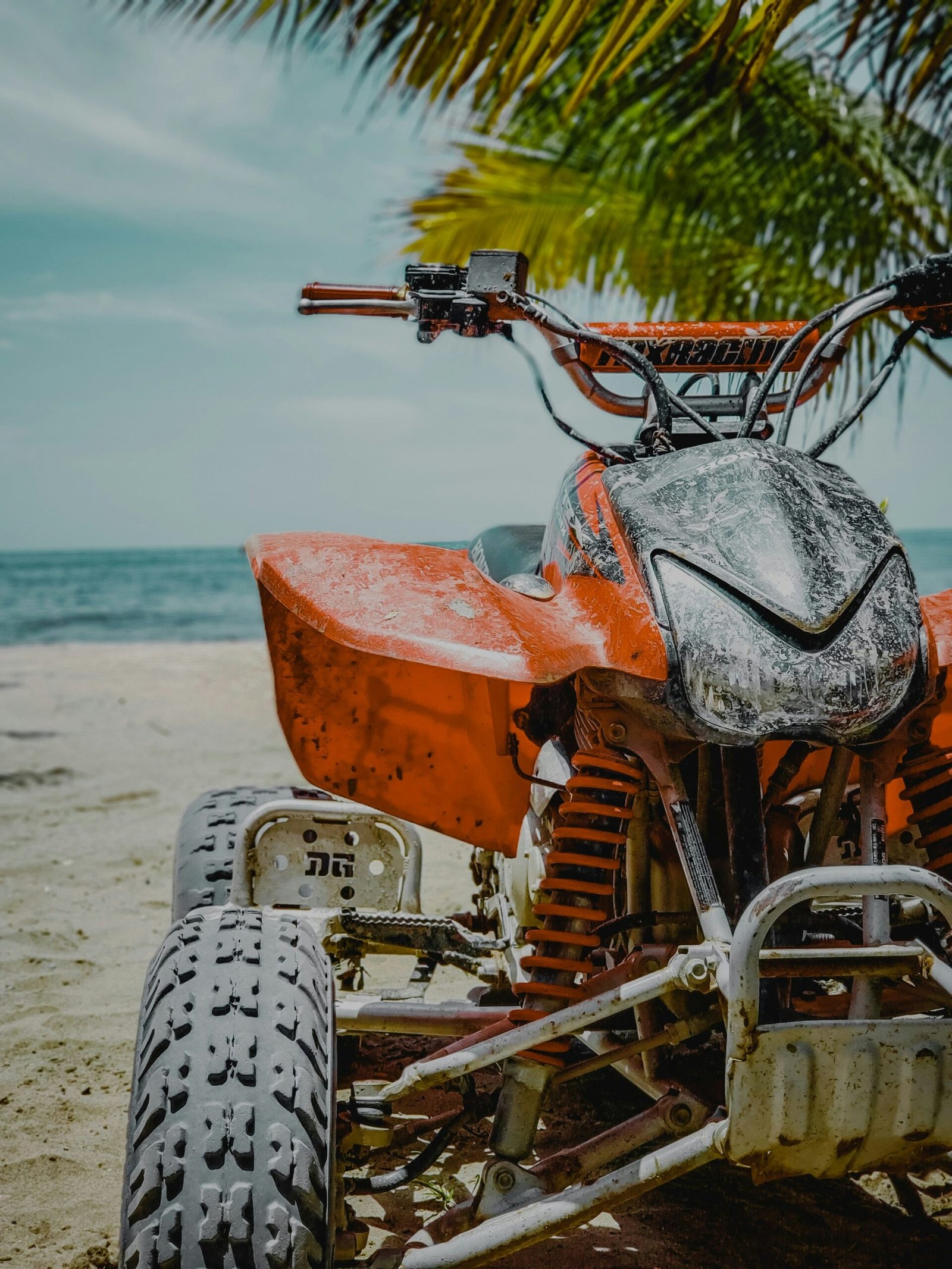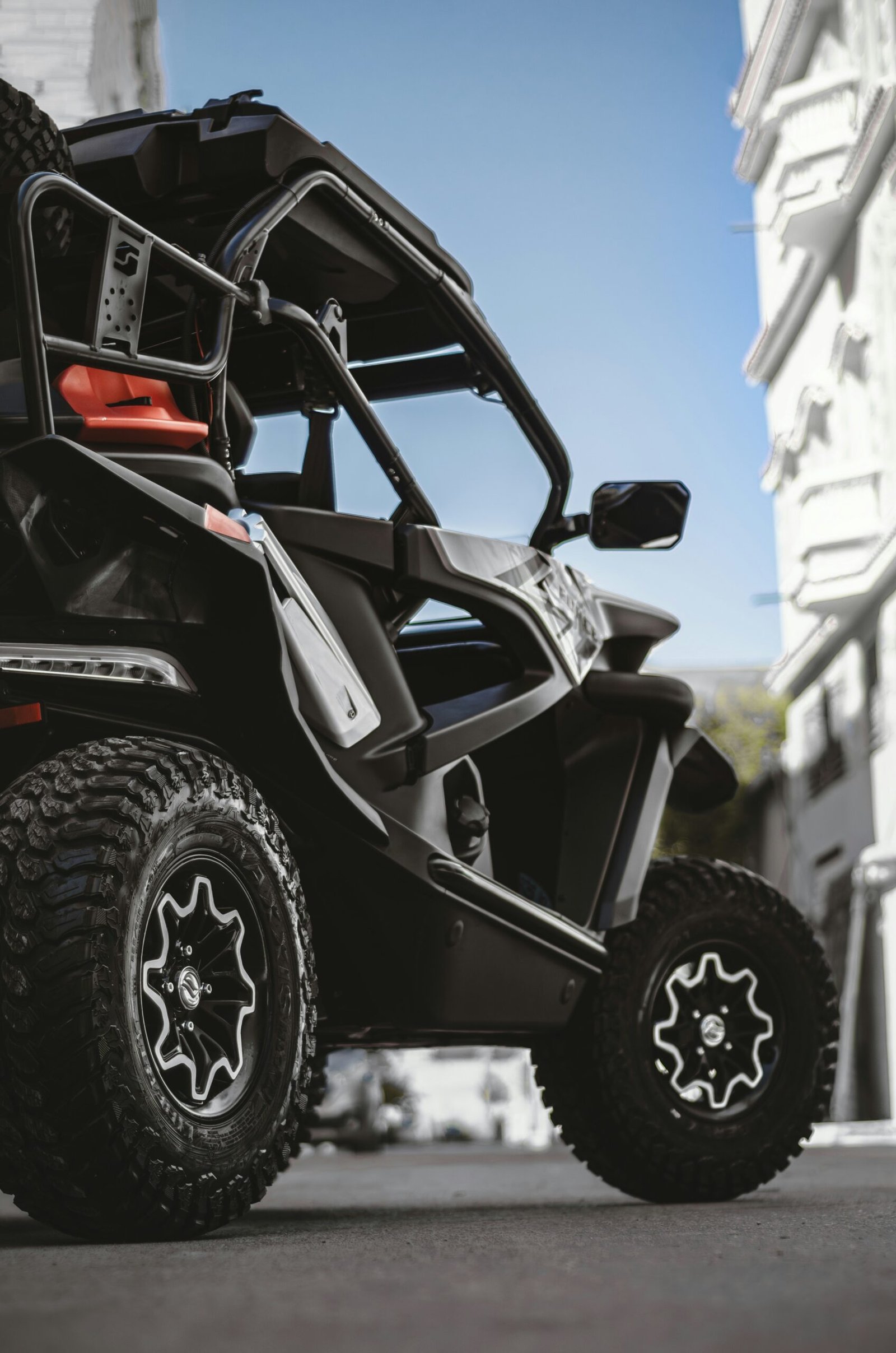In this article, you will explore the fascinating world of ATV tire tread patterns and gain a deeper understanding of their significance. From aggressive lug patterns to more versatile designs, each tread pattern serves a distinct purpose in enhancing your ATV’s performance and maneuverability. By delving into the intricacies of these patterns, you will be equipped with the knowledge needed to choose the perfect tire tread for your off-road adventures. So, buckle up and join us on this exhilarating journey as we decipher the code behind different ATV tire tread patterns!

This image is property of images.unsplash.com.
1. All-Purpose Tread Patterns
What are all-purpose tread patterns?
All-purpose tread patterns are designed to provide a balanced performance across various terrains. These patterns typically feature a combination of different tread elements, including small lugs, grooves, and channels. They are versatile and can handle a wide range of conditions, making them suitable for riders who enjoy exploring different types of terrain.
Advantages of all-purpose tread patterns
One of the main advantages of all-purpose tread patterns is their versatility. They perform well in different environments, including mud, sand, rocks, and trails. This versatility allows riders to confidently tackle various terrains without the need to switch tires frequently. All-purpose tread patterns also offer good traction and stability, providing riders with a smooth and enjoyable riding experience.
Disadvantages of all-purpose tread patterns
While all-purpose tread patterns offer versatility, they may not excel in specific terrains. They are not specifically designed for extreme conditions such as deep mud or deep snow. In these situations, riders may find that tires with specialized tread patterns perform better. Additionally, all-purpose tread patterns may not provide the same level of traction and grip as tires designed specifically for certain terrains.
Best applications for all-purpose tread patterns
All-purpose tread patterns are ideal for riders who enjoy a mix of terrains and want a tire that can handle various conditions. They are great for recreational riders who want to explore different trails and terrains without having to change their tires. All-purpose tread patterns are also suitable for riders who primarily ride on well-maintained trails but occasionally encounter mud, sand, or rocks.
2. Mud-Specific Tread Patterns
What are mud-specific tread patterns?
Mud-specific tread patterns are designed to excel in muddy and wet conditions. These patterns typically feature deep, widely spaced lugs that help to shed mud and maintain traction. The deep channels and aggressive tread design allow the tire to evacuate mud more effectively, preventing it from clogging the tire and reducing performance.
Advantages of mud-specific tread patterns
Mud-specific tread patterns offer several advantages in muddy conditions. The deep, widely spaced lugs provide excellent traction and prevent the tire from getting stuck in the mud. The aggressive tread design and deep channels help to channel mud away from the tire, maintaining maximum traction. These tires also have self-cleaning properties, ensuring that mud does not build up and affect performance.
Disadvantages of mud-specific tread patterns
While mud-specific tread patterns excel in muddy conditions, they may not perform as well in other terrains. The deep lugs and aggressive tread design can create a rougher ride on hard-packed or rocky surfaces. Additionally, the large gaps between the lugs can reduce stability on uneven terrain, making it important to adjust riding style accordingly.
Best applications for mud-specific tread patterns
Mud-specific tread patterns are perfect for riders who frequently encounter muddy or wet conditions. They are ideal for riders who enjoy mud bogs, swampy areas, or wet trails. These tires provide the necessary traction, self-cleaning properties, and mud shedding capabilities to keep riders moving through even the stickiest mud.

This image is property of images.unsplash.com.
3. Sand-Specific Tread Patterns
What are sand-specific tread patterns?
Sand-specific tread patterns are designed to excel in sandy conditions. These patterns typically feature paddle-like or scoop-shaped treads that offer excellent traction and flotation on loose and soft sand. The wide spacing between the treads helps to prevent the tire from digging into the sand, allowing for better maneuverability and control.
Advantages of sand-specific tread patterns
Sand-specific tread patterns offer several advantages in sandy conditions. The paddle-like or scoop-shaped treads provide maximum traction on loose sand, allowing riders to confidently navigate sandy trails and dunes. The wide spacing between the treads helps to prevent the tire from getting bogged down in the sand, ensuring better flotation and reducing the chances of getting stuck.
Disadvantages of sand-specific tread patterns
While sand-specific tread patterns perform exceptionally well in sand, they may not perform as well in other terrains. The paddle-like or scoop-shaped treads can make the tires less effective on harder surfaces and can create a rougher ride. Additionally, the wide spacing between the treads can reduce stability on rocky or uneven terrain.
Best applications for sand-specific tread patterns
Sand-specific tread patterns are perfect for riders who frequent sandy beaches, deserts, or dunes. They are ideal for riders who enjoy the thrill of riding on loose sand and require maximum traction and flotation. These tires provide the necessary paddle-like treads and wide spacing to ensure a fun and effortless ride on sandy terrains.
4. Rock-Specific Tread Patterns
What are rock-specific tread patterns?
Rock-specific tread patterns are designed to excel in rocky and rugged terrains. These patterns typically feature strong and durable sidewalls, along with aggressive tread patterns that include sharp edges, deep grooves, and reinforced lugs. These factors help provide maximum traction and grip on rocky surfaces while also protecting the tire from damage.
Advantages of rock-specific tread patterns
Rock-specific tread patterns offer several advantages in rocky terrains. The aggressive tread patterns and sharp edges provide excellent grip and traction on uneven surfaces, allowing riders to tackle challenging rock crawling areas with ease. The strong and durable sidewalls protect the tire from punctures and cuts that are common in rocky environments.
Disadvantages of rock-specific tread patterns
While rock-specific tread patterns perform exceptionally well in rocky terrains, they may not perform as well in other conditions. The sharp edges and deep grooves can make the tires less effective on softer terrains, such as mud or sand. Additionally, the aggressive tread patterns can create a rougher ride on smoother surfaces.
Best applications for rock-specific tread patterns
Rock-specific tread patterns are perfect for riders who enjoy rock crawling, technical trails, and rugged terrain. They are ideal for off-road enthusiasts who regularly encounter large rocks, boulders, and uneven surfaces. These tires provide the necessary grip, traction, and sidewall protection to conquer even the most challenging rock formations.

This image is property of images.unsplash.com.
5. Snow-Specific Tread Patterns
What are snow-specific tread patterns?
Snow-specific tread patterns are designed to excel in snowy and icy conditions. These patterns typically feature deep grooves, serrated edges, and siping to provide maximum traction on slippery surfaces. They often incorporate specialized rubber compounds that stay pliable in freezing temperatures, ensuring optimal grip and performance.
Advantages of snow-specific tread patterns
Snow-specific tread patterns offer several advantages in snowy and icy conditions. The deep grooves and serrated edges help to dig into the snow and ice, providing excellent traction and grip. The siping on the tread blocks allows for better flexibility, enhancing traction on slippery surfaces. The specialized rubber compounds ensure that the tires remain effective even in freezing temperatures.
Disadvantages of snow-specific tread patterns
While snow-specific tread patterns perform exceptionally well in snowy conditions, they may not perform as well in other terrains. The deep grooves and specialized design can reduce stability on dry or wet surfaces, and the softer rubber compounds may wear more quickly on non-snowy terrains.
Best applications for snow-specific tread patterns
Snow-specific tread patterns are perfect for riders who frequently ride in snowy or icy conditions. They are ideal for winter recreational riding, snowmobile trails, and areas with heavy snowfall. These tires provide the necessary traction, grip, and pliability to ensure a safe and enjoyable ride in winter conditions.
6. Racing Tread Patterns
What are racing tread patterns?
Racing tread patterns are designed to maximize performance on race tracks and competition environments. These patterns typically feature aggressive tread designs with shallow and closely spaced lugs. The focus is on maximizing traction, acceleration, and maneuverability while sacrificing some durability.
Advantages of racing tread patterns
Racing tread patterns offer several advantages in racing and competitive environments. The aggressive tread designs and shallow lugs provide maximum grip, allowing riders to achieve faster acceleration and better cornering. The closely spaced lugs ensure minimal rolling resistance, resulting in improved speed and performance on race tracks.
Disadvantages of racing tread patterns
While racing tread patterns excel in racing conditions, they may not perform as well in other terrains. The shallow lugs and aggressive tread design may not have the same level of traction and durability as other tire types. These tires are optimized for speed and performance, which can compromise their performance on rough or extreme terrains.
Best applications for racing tread patterns
Racing tread patterns are perfect for riders who participate in ATV races and other competitive events. They are ideal for riders who require maximum acceleration, cornering, and speed on race tracks. These tires provide the necessary traction and performance enhancements to give riders a competitive edge in racing environments.
7. Trail-Specific Tread Patterns
What are trail-specific tread patterns?
Trail-specific tread patterns are designed to provide a balanced performance on a variety of trails and terrains. These patterns typically feature a combination of smaller lugs, wider-spaced knobs, and interlocking tread blocks. They offer a good compromise between traction, durability, and versatility, making them suitable for riders who enjoy trail riding.
Advantages of trail-specific tread patterns
Trail-specific tread patterns offer several advantages for trail riding. The combination of smaller lugs, wider-spaced knobs, and interlocking tread blocks provides excellent traction on a variety of terrains without compromising ride quality. These tires deliver a smooth and comfortable ride, while still offering good performance in mud, sand, rocks, and other trail conditions.
Disadvantages of trail-specific tread patterns
While trail-specific tread patterns offer versatility and performance on various terrains, they may not excel in extreme conditions. They are not specifically designed for deep mud, heavy snow, or racing conditions. Riders who frequently encounter these extreme terrains may find that tires with specialized tread patterns perform better.
Best applications for trail-specific tread patterns
Trail-specific tread patterns are perfect for riders who enjoy recreational trail riding and exploring different terrains. They are ideal for riders who want a tire that can perform well in a variety of trail conditions without sacrificing comfort or durability. These tires provide the necessary traction and versatility to make the most of every trail adventure.
8. Paddle Tread Patterns
What are paddle tread patterns?
Paddle tread patterns, commonly found on sand dune tires, are specifically designed for riding in sandy environments. These patterns feature large, individual paddles that resemble the blades of a paddlewheel. The large surface area of the paddles allows for maximum traction and flotation on loose sand.
Advantages of paddle tread patterns
Paddle tread patterns offer several advantages when riding in sandy environments. The large, individual paddles provide maximum traction, allowing riders to conquer the steep, sandy hills commonly found in sand dunes. The unique design of the paddles also allows for better flotation, preventing the tire from sinking or getting stuck in the soft sand.
Disadvantages of paddle tread patterns
While paddle tread patterns excel in sandy conditions, they may not perform as well in other terrains. The large paddles are less effective on hard-packed or rocky terrains, and the unique design can create a rougher ride. Additionally, the wide spacing between the paddles can reduce stability on uneven or soft-packed surfaces.
Best applications for paddle tread patterns
Paddle tread patterns are perfect for riders who enjoy sand duning, riding on sandy beaches, or exploring desert landscapes. They are ideal for riders who want maximum traction and flotation on loose sand. These tires provide the necessary paddle-shaped treads to ensure an exciting and enjoyable ride in sandy terrains.
9. Bias Ply vs. Radial Tires
Explanation of bias ply and radial tires
Bias ply and radial tires are two different types of construction methods used in manufacturing ATV tires. Bias ply tires have a construction where the plies are laid diagonally across the tire, overlapping each other. In radial tires, the plies are arranged radially from the center of the tire, creating a 90-degree angle with the tread.
Pros and cons of bias ply tires
Bias ply tires offer several advantages. They are generally more affordable than radial tires, making them a popular choice for budget-conscious riders. Bias ply tires also have a stronger sidewall, providing better resistance to cuts and punctures. However, bias ply tires tend to have a stiffer ride, reduced fuel efficiency, and can generate more heat due to their construction.
Pros and cons of radial tires
Radial tires offer several advantages compared to bias ply tires. They provide superior ride comfort and better traction due to the flexible sidewalls and tread. Radial tires also have lower rolling resistance, resulting in improved fuel efficiency and reduced heat generation. However, radial tires are generally more expensive than bias ply tires and may be more susceptible to sidewall damage.
Choosing the right tire type for your needs
When choosing between bias ply and radial tires, consider your riding style and preferences. Bias ply tires are a suitable choice for riders on a budget, those who prioritize sidewall strength, and those who engage in more aggressive riding on rough terrains. Radial tires are ideal for riders seeking comfort, better traction, improved fuel efficiency, and a smoother overall ride.
10. Proper Tire Maintenance
Importance of tire maintenance
Proper tire maintenance is crucial to ensure optimum performance, safety, and longevity of your ATV tires. Regular maintenance helps to prolong tire life, improve fuel efficiency, and maintain optimal traction and handling on various terrains. Neglecting tire maintenance can result in decreased performance, increased risk of accidents, and premature tire wear.
Inspecting and rotating tires
Regularly inspecting your tires is essential. Check for signs of damage, such as cuts, punctures, or uneven wear. Inspect the sidewalls for signs of cracking or bulging. If you notice any issues, it’s important to address them promptly. Rotating your tires regularly helps to ensure even wear and prolonged tire life. Follow the manufacturer’s recommendations for rotation intervals.
Proper inflation and recommended tire pressure
Maintaining proper tire inflation is crucial. Underinflated tires can result in poor handling, reduced traction, and excessive heat buildup, leading to tire failure. Overinflated tires can cause a harsh ride, reduced traction, and increased vulnerability to damage. Refer to your ATV owner’s manual or consult with a tire professional to determine the recommended tire pressure for your specific ATV and riding conditions.
Replacing worn-out tires
Regularly inspect your tires for signs of wear and tread depth. Worn-out tires with insufficient tread depth greatly compromise traction and handling, particularly on wet or uneven terrains. The general guideline is to replace ATV tires when the remaining tread depth reaches 4/32 of an inch. Be sure to choose tires that are appropriate for your riding style and the terrains you typically encounter.
In conclusion, understanding the different ATV tire tread patterns is essential for selecting the right tires that match your riding style and the terrains you frequently encounter. Whether you prefer all-purpose tread patterns for versatility or specialized tread patterns for specific terrains, choosing the right tire can greatly enhance your ATV riding experience. Additionally, practicing proper tire maintenance, such as regular inspections, proper inflation, and timely replacements, ensures optimal performance, safety, and longevity of your ATV tires. Remember, a well-maintained and properly matched set of tires can make all the difference in conquering various terrains with confidence and enjoying your ATV adventures to the fullest.




